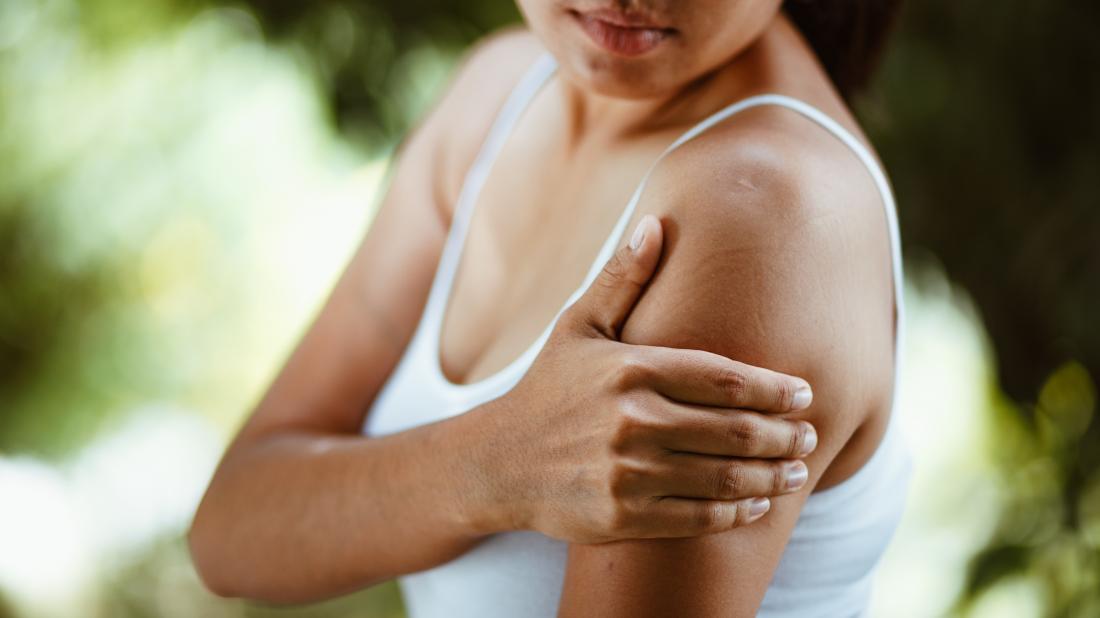Many things, including infections and blocked pores, can cause a person to develop pimples on the arms. Because the fabric of clothes usually covers this part of the body, sweat or dirt can collect and clog the pores. Simple remedies and prevention tips can treat these pimples in many cases.
A pimple is a swollen, red spot that is often full of pus. Pimples, or zits, can develop anywhere on the body. Causes include the body producing too much oil, a clogged pore, or a medical condition. The condition keratosis pilaris often affects the skin on the arms, for example.
Pimples can look different depending on the person or the cause. They may appear as red, swollen, small raised bumps, blackheads, or white due to pus.
In this article, we cover some of the possible causes of pimples on the arms. We also discuss some treatments and prevention methods.
Acne
woman touching pimples on arms
Pimples may develop on a person’s arms for various reasons.
Acne is an extremely common skin condition.
Characterized by pimples that can range in appearance from red to black, acne can affect any part of the body. It is most common on the face, back, shoulders, and upper arms.
Acne can affect people of any age, race, and sex. One common trigger for acne is hormone changes, so it commonly affects young adults.
Acne causes the body to produce too much oil, or sebum, which mixes with dead skin cells to block the pores. Bacteria on the skin infect these blocked pores, which causes pimples.
Keratosis pilaris
Keratosis pilaris is a skin condition that causes small, rough bumps to develop on the skin. The bumps are most common on the upper arms and the front of the thighs.
Dead skin blocks the pores and causes bumps. Keratosis pilaris may cause itching but is otherwise harmless.
Hives
Hives can appear as small red spots, which may itch, anywhere on the skin.
Sometimes, they are the result of an allergic reaction. An insect bite may also cause them to develop.
A reaction to a skin irritant, heat, or stress usually causes the rash.
Staph infection
A staph infection can cause red pimples or a rash, though it may also look like sores or blisters. Staph bacteria live on parts of the skin such as the armpits and nose. If these bacteria enter a cut, it can cause a staph infection.
It is important to treat staph promptly, as it can sometimes cause complications. If the infection reaches organs in the body, it can potentially become fatal.
A person should see a doctor if they suspect that they have a staph infection.
Folliculitis
Wearing tight clothing may cause folliculitis.
Folliculitis affects hair follicles and can appear anywhere there are follicles on the body. When hair follicles sustain damage, bacteria can get in and cause an infection. This usually appears as red spots on the skin.
The symptoms of folliculitis may look similar to acne.
Shaving, rubbing the skin, and wearing tight clothing can all damage hair follicles. This is more likely to happen when the skin is warm and damp.
Treatment
Skin infections that cause pimples often go away without treatment. Applying a warm washcloth to the skin can help ease the symptoms of folliculitis.
Sometimes, a staph infection requires treatment with antibiotics. This is likely to be the case if a person has a rash that lasts for longer than a week, gets worse, or spreads rapidly.
Seek medical advice if the cause of hives is not clear. An allergy test can often help pinpoint the cause of the reaction. A person can then avoid this allergen to prevent a future reaction.
Acne may require treatment with medication. Topical treatments include creams and lotions that a person applies to the skin. These kill the bacteria or reduce the amount of oil the skin makes and can take 4–8 weeks to work. Continuing with treatment after this can help prevent acne reoccurring.
Laser therapy, light therapy, and chemical peels are other options to treat acne. These can help remove bacteria from the skin or remove the top layer of the skin to clear pores.
Treating dry skin can help clear keratosis pilaris, or lessen the appearance of pimples. Applying a moisturizer two or three times per day can keep skin from drying out. Massage gently into the skin after a shower or bath for the best results.
Gentle exfoliation can help keep pores free from dead skin. Manual exfoliation involves gently massaging the skin with something rough, such as a loofah. Chemical exfoliation uses a mild chemical such as salicylic acid to clear dead skin cells.
Prevention
Showering after exercising can help prevent pimples.
It may not always be possible to prevent pimples from forming on the arms. Acne or an infection may need treatment with medication.
There are some simple ways to keep skin healthy that can help prevent pimples. Good hygiene can prevent dirt and sweat from blocking pores. It is important to shower after exercise, and to wash clothes regularly.
Frequently touching the skin can transfer more oil and bacteria onto the skin and into the pores. Popping pimples can also damage the skin and may lead to an infection.
Having a skin care regimen can help prevent pimples. Use a mild soap to wash, exfoliate gently once or twice per week, and moisturize the skin after bathing or showering.
Wearing tight clothing or straps can stop air getting to the skin and may cause irritation. Opting for loose, breathable fabrics such as cotton may help.
Outlook
Pimples on the arms may be an ongoing condition, but symptoms can often improve with simple changes. Keeping the skin clean and moisturized often helps.
Treatment may take time to work and relieve symptoms. Once symptoms have gone, continuing to care for the skin can prevent future breakouts.
Source https://www.medicalnewstoday.com/articles/325091.php
